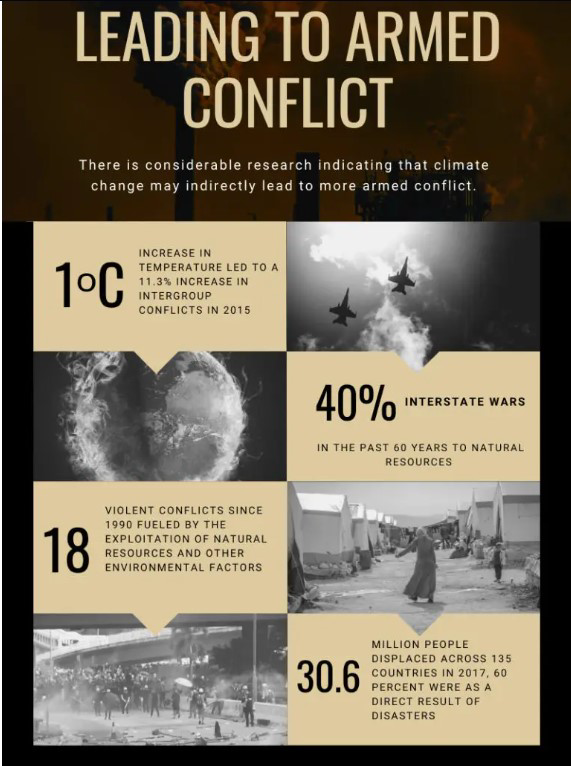Disclaimer:
Please be aware that the content herein has not been peer reviewed. It consists of personal reflections, insights, and learnings of the contributor(s). It may not be exhaustive, nor does it aim to be authoritative knowledge.
Title
Please provide a name for your action learning plan.
Climate Security
Challenge statement
Challenge type: If you are working on multiple challenges, please indicate if this is your "big bet" or "exploratory" challenge.
Please note: we ask you to only submit a maximum of 3 challenges - 1x Big Bet, 2x Exploratory. Each challenge must be submitted individually.
EXPLORATORY
Challenge statement: What is your challenge? (Please answer in specific terms: "Our challenge is that...”.)
Our challenge is that there is an initial indication on the nexus between climate change and conflict in Indonesia [1]. It is critical to acknowledge the possibility that the hardship communities face due to climate change could enable entry to radicalism and conflict. The lab therefore aims to address this by creating this preliminary project as a first step towards designing and implementing an integrated approach that address a potential multifaceted issue that increases vulnerabilities in communities.
[1] https://www.iseas.edu.sg/wp-content/uploads/2022/01/ISEAS_Perspective_2022_15.pdf
Background: What is the history of your challenge? What is causing or driving it? Who is involved? How does the current situation look like? What undesired effects does it produce?
The security implications of climate change have become a focus for world leaders and global policymakers in recent years. One of the leading security concerns about climate change is its potential to spark violent intra-state conflicts. [1]
Climate change is the main drivers behind the climate security phenomenon. The impacts of the climate change in this decade becoming more apparent, reflected by the frequency and intensity of cascading impacts of these events on socio-economic system. The aftermath of these is a widespread of consequences that includes irreversible losses of ecosystems, reduced food and water security and the emergence of vector diseases in many parts of the globe. Climate change is also contributing to communities' displacement through mass migration and increasing adverse economic effects, such as loss of livelihoods, damage of infrastructures, and destruction of businesses. Such impacts have escalated even more on the individual levels, driving psychological drivers of radicalization and dissatisfaction with governments, making community member susceptible to adopt extremist ideologies. [2]
In this context, various key stakeholders play pivotal roles, including the Government of Indonesia (GoI). To provide adequate protection against risk from natural and climate-related hazards, the Government of Indonesia is currently finalizing the Adaptive Social Protection (ASP) Roadmap, aimed to bring together social protection, climate change adaptation and disaster risk management sector. [3]
Nevertheless, several studies have documented that it is critical to acknowledge the possibility that the hardship communities' faced due to climate change could enable entry of radicalism and terrorism.
[1] https://www.securitycouncilreport.org/atf/cf/%7B65BFCF9B-6D27-4E9C-8CD3-CF6E4FF96FF9%7D/climate_security_2021.pdf
[2] https://adelphi.de/en/publications/insurgency-terrorism-and-organised-crime-in-a-warming-climate
[3] https://www.ilo.org/jakarta/info/public/pr/WCMS_885472/lang--en/index.htm
Quantitative evidence: What (official) data sources do you have on this challenge that better exemplifies the importance and urgency of this frontier challenge? You can add text, a link, or a picture.
There is considerable research indicating that climate change may indirectly lead to more armed conflict. A number of studies conducted in 2015 indicated that fluctuations in temperatures and precipitation patterns systematically increased conflict, where every 1ᵒC increase in temperature led to a 2.4% and 11.3% increase in interpersonal (i.e. assault and murder) and intergroup (i.e. riots or civil wars) conflict respectively. [1] In its 2011 Human Development Report, the UNDP attributed 40% of intrastate wars occurring in the past 60 years to natural resources, with at least 18 violent conflicts since 1990 fueled by the exploitation of natural resources and other environmental factors. [2] While it may be argued that a direct correlation between the two does not exist, climate change has been labeled as a ‘threat multiplier’,[3] with its tendency to construct a causal chain resulting in the creation or exacerbation of conflict. It may serve as a catalyst for reduced food security, compromised livelihood of vulnerable factions and resource scarcity, which ultimately pave the way for conflict.
[1] https://www.annualreviews.org/doi/pdf/10.1146/annurev-economics-080614-115430
[2] http://hdr.undp.org/sites/default/files/reports/271/hdr_2011_en_complete.pdf
[3] https://cdn.sida.se/app/uploads/2020/12/01105650/working-paper-climate-change-and-conflict.pdf

Qualitative evidence: What weak signals have you recently spotted that characterizes its urgency? Please provide qualitative information that better exemplifies the importance and urgency of this frontier challenge. You can add text, a link, or a picture.
The correlation between climate-change and conflict is two-fold; while climate change can precipitate conflict, existing conflict within regions can also exacerbate the effects of climate change. [1] According to the Notre Dame Global Adaptation Initiative (ND-Gain) Index, countries grappling with conflict, like Yemen, Mali, Afghanistan, Democratic Republic of the Congo and Somalia, were ranked amongst the lowest on the basis of countries’ level of vulnerability to climate change and their ability to increase resilience. [2] Due to the deterioration in their capability to adapt to demanding circumstances, conflict-stricken countries are more fragile in the face of the implications of climate change. Conflicted regions may witness water, soil and land contamination, due to explosive remnants, reduced governance of authorities and displacement strains. It further amplifies the vulnerability of marginalized factions of communities facing compromised socio-economic conditions, subjecting them to harsher implications and shocks of climate-change due to previously exacerbated food and economic insecurities and health disparities, and limited access to services. [3] Similarly, literature focusing on South Asia and South-East Asia categorize the regions as being greatly affected by both climate change and conflict. Coastal areas of Indonesia faced an upward spike in piracy-related activities seemingly due to reduced income opportunities from fishing. [4]
[1] https://www.icrc.org/en/document/climate-change-and-conflict
[2] https://gain.nd.edu/our-work/country-index/rankings/
[3] https://www.icrc.org/sites/default/files/topic/file_plus_list/rain_turns_to_dust_climate_change_conflict.pdf
[4] https://www.sipri.org/sites/default/files/2018-09/sipriinsight1804.pdf

Value proposition: What added value or unique value proposition is your Accelerator Lab bringing to solving this challenge? Why is it your Lab that needs to work on this challenge and not other actors within UNDP, other stakeholders in the country respectively? Why is it worth investing resources to this challenge?
As an agile network within the UNDP network, the UNDP Accelerator Lab in Indonesia is strategically situated between grassroots communities (including indigenous communities) and government stakeholders. The Accelerator Lab is well-positioned to explore ways to foster partnerships between these actors in creating more responsive institutions and a more resilience disaster and conflict mitigation efforts. The Lab aspires to partner with key government agencies, CSO, and local communities to explore the nexus between climate change impact and conflict in communities, thereby informing policymakers to create a more evidence-based policy in addressing the climate security issue.
Internally, within UNDP Indonesia CO, this initiative presents a new opportunity for support to and collaboration with the Democratic Governance and Poverty Reduction Unit (DGPRU), Resilience and Reconstruction Unit (RRU), as well as the unit's new partnership with Kemenko PMK (Coordinating Ministry of Human Development and Cultural Affairs) and other stakeholders. This aligns well with UNDP concepts of governance, which is at the forefront of the consensus that good governance and sustainable human development are indivisible. This means, that communities, particularly the poor and vulnerable, are at the center of the development process.
Short “tweet” summary: We would like to tweet what you are working on, can you summarize your challenge in a maximum of 280 characters?
UNDP Accelerator Lab Indonesia is collaborating with Government of Indonesia and local community to explore the nexus between climate change impact and conflict in communities.
Partners
Who are your top 5 partners for this challenge? Please submit from MOST to LEAST important and state Name, Sector and a brief description of the (intended) collaboration.
Please state the name of the partner:
Coordinating Ministry for Human Development and Cultural Affairs
What sector does our partner belong to?
Private Sector
Please provide a brief description of the collaboration.
Coordinating Ministry for Human Development and Cultural Affairs is an Indonesian government coordinating ministry. The ministry is responsible to coordinate, synchronize and control governance in human development and culture. The main role of Coordinating Ministry for Human Development and Cultural Affairs in this collaboration is to work together to develop strategies for preserving cultural diversity and promoting social cohesion as resilience measures in the face of climate-related challenges.
Is this a new and unusual partner for UNDP?
Yes
Learning questions
Learning question: What is your learning question for this challenge? What do you need to know or understand to work on your challenge statement?
1. What is the evidence that demonstrates the connection between climate change effects and drivers of conflict?
2. What is the most appropriate framework for addressing challenges in climate and conflict?
3. What are the potential roles for multistakeholder cooperation in advancing climate action as a potential entry point to peacebuilding efforts?
To what stage(s) in the learning cycle does your learning question relate?
Sense, Explore
Usage of methods: Relating to your choice above, how will you use your methods & tools for this learning question? What value do these add in answering your learning question?
In order to develop an understanding of the climate security landscape in Indonesia, Foresight method can be used to explore the future and anticipate changes caused by climate security issue. Meanwhile, ethnographic methods, which include surveys, interviews and FGDs, will be employed to assess aspects such as climate data, socioeconomic data, history of conflict, etc. Data collection will also expect to be utilized to confirm the nexus between climate change and conflict specific to the context of pilot location.
Existing data gaps: Relating to your choice above, what existing gaps in data or information do these new sources of data addressing? What value do these add in answering your learning question?
Currently, there is limited localized data connecting specific climate impacts to conflicts triggers in Indonesia. The introduction of new data sources such as foresight methods and ethnographic approaches to investigate the connection between climate change effects and drivers of conflict in Indonesia and Southeast Asia addresses critical existing data gaps. Firstly, these methods provide a forward-looking perspective, allowing for the anticipation of future changes driven by climate security issues, a dimension often missing in traditional datasets. Secondly, ethnographic methods, including surveys, interviews, and focus group discussions, offer a deeper exploration of the local context, encompassing historical, cultural, and socioeconomic factors. This holistic approach enhances our understanding of the complex interplay between climate change and conflict in the region, filling gaps in existing fragmented or incomplete data. Furthermore, data collected through these methods can confirm the nexus between climate change and conflict specific to the pilot location, providing valuable evidence for policymaking and peacebuilding efforts in this relatively new field of study in Indonesia and Southeast Asia.
Closing
Early leads to grow: Think about the possible grow phase for this challenge - who might benefit from your work on this challenge or who might be the champions in your country that you should inform or collaborate with early on to help you grow this challenge?
After successfully addressing the challenge of understanding the intricate relationship between climate change effects and conflict drivers in Indonesia and Southeast Asia, the next pivotal phase involves expansion and application of the knowledge gained.
END OF ACTION LEARNING PLAN: Thank you! The form saves automatically and your submission has been recorded. You may now exit this window.


 13
13

 16Peace, justice and strong institutions
16Peace, justice and strong institutions
Comments
Log in to add a comment or reply.